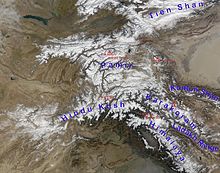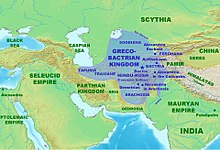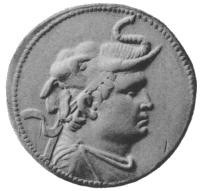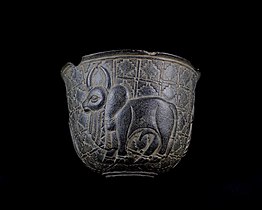Bactria
| Bactria Balkh | |
|---|---|
| Province of the Achaemenid Empire, Seleucid Empire, and Greco-Bactrian Kingdom | |
| 2500/2000 BC–900/1000 AD | |
Approximate location of the region of Bactria Bactra | |
| Historical era | Antiquity |
• Established | 2500/2000 BC |
• Disestablished | 900/1000 AD |
| Today part of | Afghanistan Tajikistan Uzbekistan |
Bactria (/ˈbæktriə/; Bactrian: βαχλο, Bakhlo), or Bactriana, was an ancient Iranian[1] civilization in Central Asia based in the area south of the Oxus River (modern Amu Darya) and north of the mountains of the Hindu Kush, an area within the north of modern Afghanistan. Bactria was strategically located south of Sogdia and the western part of the Pamir Mountains. The extensive mountain ranges acted as protective "walls" on three sides, with the Pamir on the north and the Hindu Kush on south forming a junction with the Karakoram range towards the east.
Called "beautiful Bactria, crowned with flags" by the
The
The
Etymology

The modern English name of the region is Bactria. Historically, the region was first mentioned in
Bactria is the geographic location Bactrian camels are named after.
Geography
The Bactrian plain lay between the Amu Darya (ancient Oxus River) to the north and the Hindu Kush mountain range to the south and east.[7] On its western side, the region was bordered by the great Carmanian desert and the plain of Margiana. The Amu Darya and smaller rivers such as (from west to east) the Shirin Tagab River, Sari Pul River, Balkh River and Kunduz River have been used for irrigation for millennia. The land was noted for its fertility and its ability to produce most ancient Greek agricultural products, with the notable exception of olives.[8]
According to Pierre Leriche:
Bactria, the territory of which Bactra was the capital, originally consisted of the area south of the Āmū Daryā with its string of agricultural oases dependent on water taken from the rivers of Balḵ (Bactra), Tashkurgan, Kondūz, Sar-e Pol, and Šīrīn Tagāō. This region played a major role in Central Asian history. At certain times the political limits of Bactria stretched far beyond the geographic frame of the Bactrian plain.[9]
History
Bronze Age
Right: Ancient bowl with animals, Bactria, 3rd–2nd millennium BC.
The
The early Greek historian
According to some writers, [
Achaemenid Empire

Under Persian rule, many Greeks were deported to Bactria, so that their communities and language became common in the area. During the reign of
Alexander The Great

Alexander conquered Sogdiana. In the south, beyond the Oxus, he met strong resistance, but ultimately conquered the region through both military force and diplomacy, marrying Roxana, daughter of the defeated Satrap of Bactria, Oxyartes. He founded two Greek cities in Bactria, including his easternmost, Alexandria Eschate (Alexandria the Furthest).
After Alexander's death,
Seleucid Empire
The Macedonians, especially Seleucus I and his son Antiochus I, established the Seleucid Empire and founded a number of Greek towns. The Greek language became dominant for some time there.
The paradox that Greek presence was more prominent in Bactria than in areas far closer to Greece can possibly be explained by past deportations of Greeks to Bactria.[22] When Alexander's troops entered Bactria they discovered communities of Greeks who appeared to have been deported to the region by the Persians in previous centuries.
Greco-Bactrian Kingdom

Considerable difficulties faced by the Seleucid kings and the attacks of Pharaoh Ptolemy II Philadelphus gave the satrap of Bactria, Diodotus I, the opportunity to declare independence about 245 BC and conquer Sogdia. He was the founder of the Greco-Bactrian Kingdom. Diodotus and his successors were able to maintain themselves against the attacks of the Seleucids—particularly from Antiochus III the Great, who was ultimately defeated by the Romans (190 BC).
The Greco-Bactrians were so powerful that they were able to expand their territory as far as South Asia:
As for Bactria, a part of it lies alongside Aria towards the north, though most of it lies above Aria and to the east of it. And much of it produces everything except oil. The Greeks who caused Bactria to revolt grew so powerful on account of the fertility of the country that they became masters, not only of Bactria and beyond, but also of India, as Apollodorus of Artemita says: and more tribes were subdued by them than by Alexander...."[23]
The Greco-Bactrians used the Greek language for administrative purposes, and the local Bactrian language was also Hellenized, as suggested by its adoption of the Greek alphabet and Greek loanwords. In turn, some of these words were also borrowed by modern Pashto.[24]
Indo-Greek Kingdom

The Bactrian king
Most of them we know only by their coins, a great many of which are found in
In the
Daxia, Tukhara and Tokharistan
Daxia, Ta-Hsia, or Ta-Hia (Chinese: 大夏; pinyin: Dàxià) was the name given in antiquity by the Han Chinese to Tukhara or Tokhara:[citation needed] the central part of Bactria. The name "Daxia" appears in Chinese from the 3rd century BC to designate a little-known kingdom located somewhere west of China. This was possibly a consequence of the first contacts between China and the Greco-Bactrian Kingdom.
During the 2nd century BC, the Greco-Bactrians were conquered by nomadic
The name Daxia was used in the

Tokharistan
The form
Introduction of Islam
By the mid-7th century AD, Islam under the Rashidun Caliphate had come to rule much of the Middle East and western areas of Central Asia.[30]
In 663 AD, the
In the 8th century AD, a Persian from Balkh known as Saman Khuda left Zoroastrianism for Islam while living under the Umayyads. His children founded the Samanid Empire (875–999 AD). Persian became the official language and had a higher status than Bactrian, because it was the language of Muslim rulers. It eventually replaced the latter as the common language due to the preferential treatment as well as colonization.[31]
Bactrian people
Several important trade routes from India and China (including the Silk Road) passed through Bactria and, as early as the Bronze Age, this had allowed the accumulation of vast amounts of wealth by the mostly nomadic population. The first proto-urban civilization in the area arose during the 2nd millennium BC.
Control of these lucrative trade routes, however, attracted foreign interest, and in the 6th century BC the Bactrians were conquered by the
The Greco-Bactrians, also known in
Bactrians were recorded in Strabo's Geography: "Now in early times the Sogdians and Bactrians did not differ much from the nomads in their modes of life and customs, although the Bactrians were a little more civilised; however, of these, as of the others, Onesicritus does not report their best traits, saying, for instance, that those who have become helpless because of old age or sickness are thrown out alive as prey to dogs kept expressly for this purpose, which in their native tongue are called "undertakers," and that while the land outside the walls of the metropolis of the Bactrians looks clean, yet most of the land inside the walls is full of human bones; but that Alexander broke up the custom."[33]
The Bactrians spoke
The principal religions of the area before the Islamic invasion were Zoroastrianism and Buddhism.[36]
The Tajiks are the direct descendants of the Iranian peoples whose continuous presence in Central Asia and northern Afghanistan is attested from the middle of the 1st millennium BC. The ancestors of the Tajiks constituted the core of the ancient population of Khwārezm (Khorezm) and Bactria, which formed part of Transoxania (Sogdiana). They were included in the empires of Persia and Alexander the Great, and they intermingled with such later invaders as the Kushāns and Hepthalites in the 1st–6th centuries AD. Over the course of time, the eastern Iranian dialect that was used by the ancient Tajiks eventually gave way to Persian, a western dialect spoken in Iran and Afghanistan.[40]
In popular culture
- The six-part documentary Alexander's Lost World explores the possible sites of Bactrian cities that historians believe were founded by Oxus civilization.[41]
- The site was portrayed in the 2004 film Alexander where Darius III was found dying.
See also
- History of Afghanistan
- History of Uzbekistan
- Bactria–Margiana Archaeological Complex
- Bactrian camel
- Bahlikas
- Dalverzin Tepe
- Greater Khorasan
- Tillya Tepe
Notes
- ^ S2CID 165176167.
- ISSN 1356-1863.
- ISSN 2689-100X.
- ^ Foundation, Encyclopaedia Iranica. "Welcome to Encyclopaedia Iranica". iranicaonline.org. Retrieved 2023-07-31.
- ^ Asiatic Papers. Bactra Retrieved 11 March 2023
- ^ Eduljee, Ed. "Aryan Homeland, Airyana Vaeja, in the Avesta. Aryan lands and Zoroastrianism". www.heritageinstitute.com. Retrieved 2017-09-07.
- ISBN 0-8160-4640-9.
- ^ Rawlinson, H. G. (1912). Bactria: The History of a Forgotten Empire. London: Probstain & co.
- ^ P. Leriche, "Bactria, Pre-Islamic period", Encyclopaedia Iranica, vol. 3, 1998.
- ^ Inagaki, Hajime. Galleries and Works of the MIHO MUSEUM. Miho Museum. p. 45.
- .
- ^ David Testen, "Old Persian and Avestan Phonology", Phonologies of Asia and Africa, vol. II (Winona Lake, Indiana: Eisenbrauns, 1997), 583.
- ^ Cotterell (1998), p. 59
- ^ Herzfeld, Ernst (1968). The Persian Empire: Studies in geography and ethnography of the ancient Near East. F. Steiner. p. 344.
- ^ "BACTRIA – Encyclopaedia Iranica". www.iranicaonline.org. Retrieved 2019-08-07.
After annexation to the Persian empire by Cyrus in the sixth century, Bactria together with Margiana formed the Twelfth Satrapy.
- ^ Holt (2005), pp. 41–43.
- ^ Chisholm 1911.
- ^ Herodotus, 4.200–204
- ^ Strabo, 11.11.4
- ^ Herodotus 6.9
- ^ "Graeco-Bactrian Kingdom". www.cemml.colostate.edu. Archived from the original on 2020-12-23. Retrieved 2020-12-12.
- ^ Walbank, 30
- ^ Strabo "Geography, Book 11, chapter 11, section 1".
- ^ UCLA Language Materials Project: Language Profile: Pashto Archived 2009-01-03 at the Wayback Machine
- ^ Bernard (1994), p. 126.
- ^ Silk Road, North China C. Michael Hogan, the Megalithic Portal, 19 November 2007, ed. Andy Burnham
- ISBN 0-8135-1304-9.
- Hanshu, Former Han History
- ^ a b Metropolitan Museum of Art exhibition
- ^ a b History of Buddhism in Afghanistan by Dr. Alexander Berzin, Study Buddhism
- ^ "Origin of the Samanids – Kamoliddin – Transoxiana 10". www.transoxiana.org. Retrieved 2017-09-07.
- JSTOR 24048765.
- ^ "LacusCurtius • Strabo's Geography — Book XI Chapter 11". penelope.uchicago.edu. Retrieved 2017-09-07.
- ^ "The Modern Eastern Iranian languages are even more numerous and varied. Most of them are classified as North-Eastern: Ossetic; Yaghnobi (which derives from a dialect closely related to Sogdian); the Shughni group (Shughni, Roshani, Khufi, Bartangi, Roshorvi, Sarikoli), with which Yaz-1ghulami (Sokolova 1967) and the now extinct Wanji (J. Payne in Schmitt, p. 420) are closely linked; Ishkashmi, Sanglichi, and Zebaki; Wakhi; Munji and Yidgha; and Pashto.
- ^ N. Sims-Williams. "Bactrian language". Encyclopaedia Iranica. Originally Published: December 15, 1988.
- ^ John Haywood and Simon Hall (2005). Peoples, nations and cultures. London.
{{cite book}}: CS1 maint: location missing publisher (link) - ^ Kazakhstan, Kyrgyzstan, Tajikistan, Turkmenistan, and Uzbekistan : country studies Federal Research Division, Library of Congress, page 206
- ^ Richard Foltz, A History of the Tajiks: Iranians of the East, London: Bloomsbury, 2019, pp. 33-61.
- Richard Nelson Frye, "Persien: bis zum Einbruch des Islam" (original English title: "The Heritage Of Persia"), German version, tr. by Paul Baudisch, Kindler Verlag AG, Zürich1964, pp. 485–498
- ^ "Tajikistan: History". 28 August 2023. Britannica Online Encyclopedia
- ^ "David Adams Films". Alexander's Lost World
Sources
- Bernard, Paul (1994). "The Greek Kingdoms of Central Asia." In: History of civilizations of Central Asia, Volume II. The development of sedentary and nomadic civilizations: 700 B.C. to A.D. 250, pp. 99–129. Harmatta, János, ed., 1994. Paris: UNESCO Publishing.
- Beal, Samuel (trans.). Si-Yu-Ki: Buddhist Records of the Western World, by Hiuen Tsiang. Two volumes. London. 1884. Reprint: Delhi: Oriental Books Reprint Corporation, 1969.
- Beal, Samuel (trans.). The Life of Hiuen-Tsiang by the Shaman Hwui Li, with an Introduction containing an account of the Works of I-Tsing. London, 1911. Reprint: New Delhi: Munshiram Manoharlal, 1973.
- Cotterell, Arthur. From Aristotle to Zoroaster, 1998; pages 57–59. ISBN 0-684-85596-8.
- Hill, John E. 2003. "Annotated Translation of the Chapter on the Western Regions according to the Hou Hanshu." Second Draft Edition.
- Hill, John E. 2004. The Peoples of the West from the Weilüe 魏略 by Yu Huan 魚豢: A Third Century Chinese Account Composed between 239 and 265 AD. Draft annotated English translation.
- Holt, Frank Lee. (1999). Thundering Zeus: The Making of Hellenistic Bactria. Berkeley: University of California Press.(hardcover, ISBN 0-520-21140-5).
- Holt, Frank Lee. (2005). Into the Land of Bones: Alexander the Great in Afghanistan. University of California Press. ISBN 0-520-24553-9.
- Waghmar, Burzine. (2020). "Between Hind and Hellas: the Bactrian Bridgehead (with an appendix on Indo-Hellenic interactions)". In: Indo-Hellenic Cultural Transactions. (2020). Edited by Radhika Seshan. Mumbai: K. R. Cama Oriental Institute, 2020 [2021], pp. 187–228. ISBN 978-938-132418-9, (paperback).
- Tremblay, Xavier (2007) "The Spread of Buddhism in Serindia ― Buddhism among Iranians, Tocharians and Turks before the 13th century." Xavier Tremblay. In: The Spread of Buddhism. (2007). Edited by Ann Heirman and Stephan Peter Bumbacher. Handbook of Oriental Studies. Section Eight, Central Asia. Edited by Denis Sinor and Nicola Di Cosmo. Brill, Lieden; Boston. pp. 75–129.
- Watson, Burton (trans.). "Chapter 123: The Account of Dayuan." Translated from the ISBN 0-231-08167-7(paperback).
- Watters, Thomas. On Yuan Chwang's Travels in India (A.D. 629–645). Reprint: New Delhi: Mushiram Manoharlal Publishers, 1973.
- Chisholm, Hugh, ed. (1911). . Encyclopædia Britannica. Vol. 3 (11th ed.). Cambridge University Press. pp. 180–181.
- Walbank, F.W. (1981). "The Hellenistic World". Fontana Press. ISBN 0-006-86104-0.
External links
- Bactrian Coins
- Bactrian Gold
- Livius.org: Bactria Archived 2014-07-31 at the Wayback Machine
- Batriane du nord—about the Termez region, an archeological site
- Art of the Bronze Age: Southeastern Iran, Western Central Asia, and the Indus Valley, an exhibition catalog from The Metropolitan Museum of Art (fully available online as PDF), which contains material on Bactria



